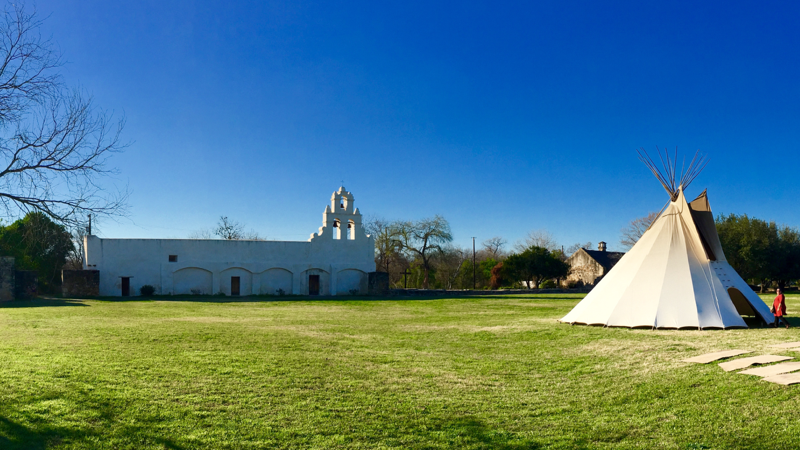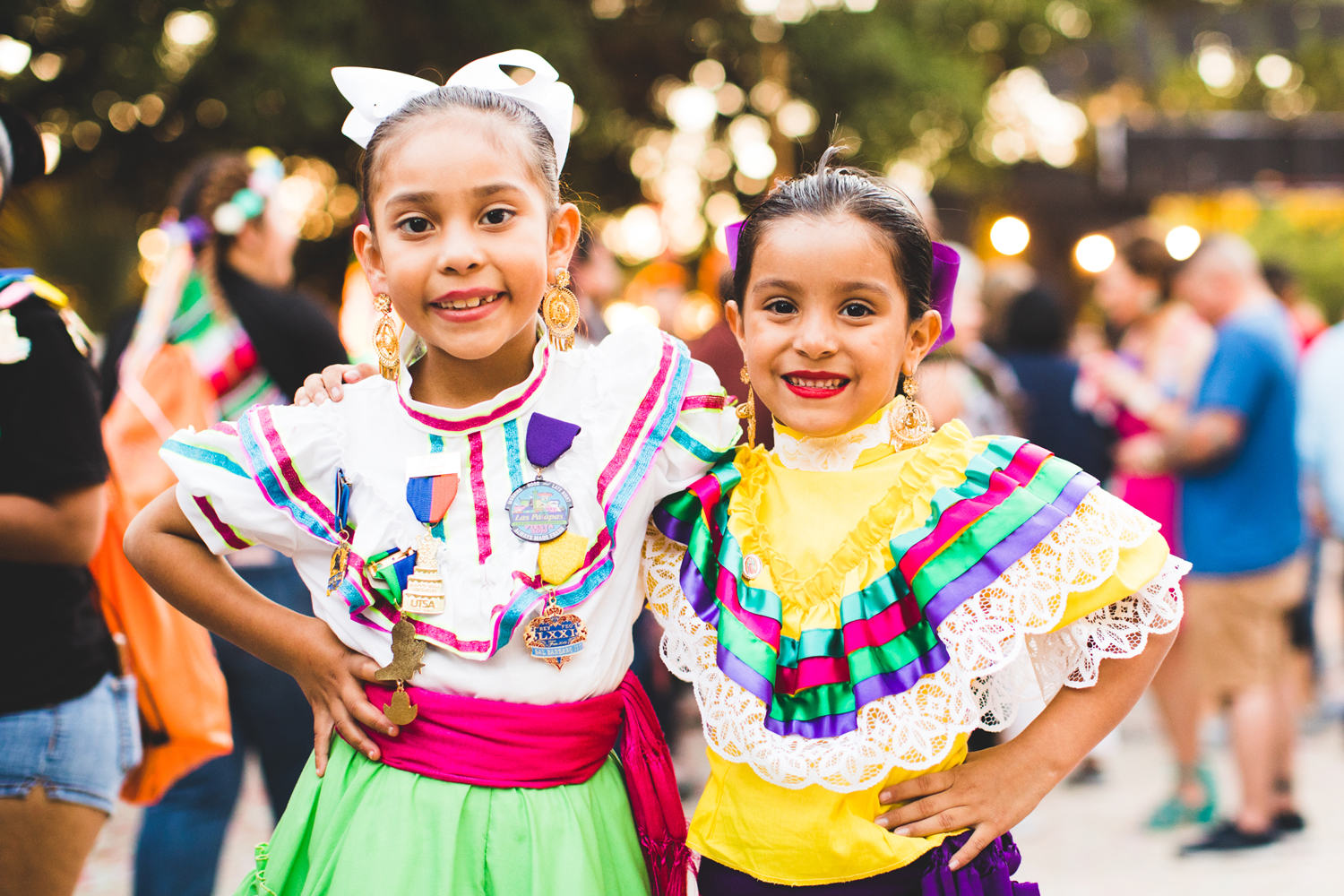Downtown San Antonio is probably best-known for its public spaces: the RiverWalk, the Alamo, and Main Plaza chief among them. But the local perception has long been that the city’s core is for tourists, not residents. Luckily, there is a considerable amount of energy being devoted to changing this perception, and remaking downtown as a place for people. There are real and concerted ongoing efforts to make liveliness the default for downtown, for the sake of the city’s residents. Collaboration between several city agencies, non-profit organizations, and companies on a variety of projects are putting serious momentum on the placemaking process. As such, one theme I want to focus on is the Renewal of the city by residents, for residents.
So far, the city has worked to revitalize and reconceptualize Alamo Plaza and Plaza de Valero, as well as Travis Park. These places have played an important role in the city’s history; this has led to their popularity with tourists, but has had the unintended side-effect of driving many locals away. One of the main goals in re-thinking these spaces has been to focus on changes that will open downtown up to a wider variety of uses.
Beyond downtown’s historic plazas, the city is also gearing up for a major overhaul of HemisFair Park and its surrounding streets. New Downtown Transportation Plans have focused on creating efficient but sustainable designs for the urban areas that most attract tourists and house local businesses. Placemaking is the practice of creating or enhancing a community’s assets to improve its overall attractiveness and livability. This includes large-scale projects such as the creation of public spaces and alternative transportation infrastructure, but also efforts on a more small scale the revolve around residential quality of life. Communities are changing the way they approach economic development. Instead of differentiating themselves primarily by transportation access, low costs, proximity to natural resources, or other traditional competitive advantages, many communities today are attracting multi-generational talent by becoming desirable places to live. More efforts are made to build active, unique locations that are visually attractive, safe, and walkable with mixed uses. City residents are encouraged to participate in the placemaking process as well, encouraging Revitalization of local neighborhoods through online platforms, such as the Power of 10, where people can share their ideas for how downtown could be improved.
Based on my research into the ongoing developments in San Antonio and its environs, I’ve attempted to distill ten “keys” to the city, as listed below. The keys range from the region’s unique ecology, to its vibrant diversity of culture and historical importance. As San Antonio’s rapidly expanding urban landscape is both encroaching upon and mingling with the natural environment, these themes focus on what needs to be preserved as well as what the people who call this city home deem most important.
10 Keys to Understanding San Antonio as a Living Place
City Issues: Environmental Sustainability
San Antonio has a proud history of conservation, ensuring our resources are available and cost-effective for our residents. Healthy, properly functioning natural ecosystems can absorb emissions. In addition to protecting and preserving existing natural ecosystems, these strategies promote the development of solutions to mimic natural responses.
As one of the fastest growing cities in the nation, one of the vision statements that the city most urgently prioritizes is the adoption of a climate plan to make San Antonio carbon neutral by 2050. Although the scope of the plan is still in its visionary stages, since they have yet to receive full commitment from large business stakeholders, the focus on benefit the way of life in the city through a plan to craft a sustainable approach to growth (by examining best practices and policies in construction; water and green space conservation ; reduction of air pollution, among others) it shows a concern with taking care of vulnerable neighbors and ecosystems. This focus on making urban and rural centers places that newcomers want to live in, and ensuring the safety and health of the full environment, most reflect a value for Renewal in the city since San Antonio considers it a collective responsibility to prepare for a future that is projected to have hotter temperatures, longer droughts and more intense rain events. Protecting San Antonio’s quality of life, economy, military, and historic treasures is a leading priority.
Working with stakeholders across jurisdictional lines will continue to be the way San Antonio achieves progress. Some key projects include: the Mayor’s Monarch Pledge, the Tree Canopy Preservation & Mitigation Fund, and Water and Energy Conservation Initiatives
City Planning: A Guide for Integrated Growth

The San Antonio Metropolitan Area is expected to add up to 1.1 million new residents, with 500,000 new jobs, and 500,000 new dwelling units by 2040. If not properly prepared for this growth, the impacts could have significant consequences. For example, traffic congestion and commute times could increase which would in turn affect our air quality and overall quality of life. SA Tomorrow is the City’s 25-year framework that guides future growth and development. It addresses a wide range of topics that affect how we experience the city. These topics include land use, economic development, housing, environmental protection, cultural and historic preservation, transportation, and more. The City’s Planning Department has launched an effort to begin implementing the SA Tomorrow Comprehensive Plan to ensure that it remains responsive to the needs of the community.
To be a place where the community can easily get around in a safe, reliable, efficient, cost-effective, and healthy way, San Antonio also prioritizes a comprehensive transportation network that provides residents and tourists alike with options for moving around the City. Collectively, these choices impact air quality and how much space are dedicated to moving people, thus helping to improve the sustainability of land use in San Antonio
A full list of the city plans can be found here: https://www.sanantonio.gov/Planning/PlanningUrbanDesign/ComprehensivePlan
Edwards Plateau

In addition to hosting the aquifer which fuels the San Antonio and other south Texas rivers, the Edwards Plateau is an ecotone, or region where multiple biomes meet. The Plateau sits at the intersection of desert to the west, prairie to the north, and hill country to the east, creating ideal conditions for abundant biodiversity and endemic species. The Edwards Plateau is home to at least 14 endemic freshwater fishes, including two subterranean species of catfish and 13 fish species considered to be spring-associated. Trees of the savanna include juniper and oak species scattered over grasses, a vegetation type historically shaped by droughts and regular fires. Some pecan trees are found near the springs and rivers.
The Texas Hill Country is a geographic region of Central and South Texas, forming the southeast part of the Edwards Plateau. Given its location, climate, terrain, and vegetation, the Hill Country can be considered the border between the American Southeast and Southwest. The Balcones Fault is also associated with the Edwards Plateau formation. This fault line is an ecological demarcation for the range definition of a number of species. Nearly all the natural habitat of the plateau has been converted to ranchland, farmland, or urban areas, such as the city of San Antonio, with only about 2% remaining in scattered fragments, especially to the east of the plateau.
The city currently sponsors the Edwards Aquifer Protection Program in hopes of protecting both the diverse fauna and the main drinking water source for the city of San Antonio and surrounding central Texas communities.
Abundance of fauna
San Antonio and its environs host many animal species. Top sites to see include Bracken Cave, which is the summer home of more than 15 million Mexican free-tailed bats, making it the world’s largest bat colony. Other parks and natural areas such as the Edwards Plateau and the Government Canyon State Natural Area are habitats for a variety of endangered animals, such as the golden-cheeked warbler and the black-capped vireo. This attracts many bird-watchers and anyone who wants to explore the beauties of nature to the local natural environs that surround the urban city. In addition to being located within the monarch butterfly’s migratory path, San Antonio also sits in the path of many bird migratory patterns.
The ecologically diverse landscape of the Hill Country is home to native species, including several on the endangered list, which are not found anywhere else in the world. Land stewardship programs, state parks and natural areas protect natural habitats and provide opportunities to view and learn about our native wildlife. Organizations ranging from the Missions National Historical Park all the way to the San Antonio Wildlife preserves aim to educate residents and tourists on the animals, both native and invasive, that have made downtown San Antonio, the Edwards aquifer, and the Hill Area, home.
Native Americans in San Antonio

Title: Native American tipi in front of San Antonio’s San Juan Mission.
Coahuiltecans in South Texas were the impetus for the San Antonio missions, showing how Native Americans formed an integral part of the formation of the history and community of San Antonio. The Mission of the American Indians in Texas at the Spanish Colonial Missions is to work for the preservation and protection of the culture and traditions of their Nation through education, research, community outreach, economic development projects and legislative initiatives.
The evolution of settlements and cultures around the Alamo area is also an important history in San Antonio as it tells the story of Native American interactions with the environment. The San Antonio area was a meeting and gathering place as well as home to different groups of Native Americans. Remains have been found that date Native Americans in this area to 8,000- 10,000 years. As the Spanish arrived and then the United States formed, the region contains the story of how national policies dispossessed Native Americans in the region. As such, the history of San Antonio is tied to the history of its Native American residents. Native Americans continue to seek their heritage within the modern city as, according to the 2010 census, San Antonio was actually the city with the 10th largest population of Native Americans per capita. With the city’s missions at the forefront of most people’s conception of San Antonio, its Native American residents continue to remember a different history for their ancestors that must still be kept alive among the hodge-podge of cultures in the city.
A History of National Importance
https://www.nps.gov/media/photo/gallery-item.htm?pg=2170472&id=CEE7BFB7-155D-451F-678C63490BAB762B&gid=CEE7BF3F-155D-451F-67BB9596C9FF5D7C
In 1978, the Spanish colonial missions in San Antonio were listed as part of the National Historic Park system. They are preserved for the enjoyment, education, and inspiration of this and future generations. The San Antonio Missions tell the stories of the people who came into the Spanish missions to live in the 1700s. Acculturating and converting the indigenous population in order to become Spanish citizens reverberates today in the southwest United States. The site consists of 5 frontier missions situated along a stretch of the San Antonio River basin in southern Texas, as well as a ranch located 37 kilometres to the south.
The most enduring symbol of independence in Texas, ‘The Alamo’ is seen as an intersection of history. Its 1744 church, is part of the remains of the mission complex established by the Franciscans as Mission San Antonio de Valero in 1718. In 1836 it was the site of the famous battle in defense of the Texas Revolution when Mexican President Santa Anna’s army annihilated approximately 190 men after a 13-day siege. The sacrifice of men such as William Travis, the commander of the garrison, James Bowie, and David Crockett, inspired General Sam Houston’s army six weeks later at the decisive battle of San Jacinto, which established Texas’ independence and its title as the Lone Star State. The Alamo Plaza Historic Site includes National Historic Landmarks, State Antiquities Landmarks, recorded Texas Historic Landmarks. San Antonio’s iconic Alamo Plaza is located at the center of the city and includes the Alamo Chapel and complex, open/public use space, and the commercial resources that developed around the plaza during the late nineteenth and twentieth century.
Immigration and cultural diversity

While San Antonio and the South Texas region prominently exhibits Mexican influence, the region has received a series of immigration waves since the early nineteenth century, including from Central and South America and Europe. The annual Texas Folklife Festival, put on by the Institute of Texan Cultures, illustrates this diversity.
Without forgetting this broad range of ethnic diversity, it is undeniable that Latin Americans and their descendants contribute enormously to San Antonio’s population and cultural life. San Antonio is 63.1% Hispanic, and the city has played a large role in the Chicano movement since the 1960s. An interesting study about Latino presence in the region is the following study by Saenz at the University of Texas at San Antonio.
San Antonio’s culture is diverse and includes even a prominent German heritage, too! In the 1840’s, a group of German noblemen formed a group called the Adelsverein to protect German immigrants coming to Texas and to secure land for them in the Texas Hill Country. Today, that land includes visitor favorites like the towns of Fredericksburg, Comfort, Boerne and New Braunfels. Also, in the late 1800’s, the King William neighborhood was settled by other prominent German merchants. Today, it’s the state’s first zoned historic district.
The San Antonio River

The San Antonio River, fed by the groundwater beneath the Edwards Plateau, attracted and sustained the indigenous Coahuiltecans and Spanish colonizers from which the community of San Antonio grew. Today, in addition to being a water source for the region’s people, animals, and plant life, the river hosts the famous San Antonio River Walk; a treasure for locals, businesses and visitors, the River Walk plays a vital role in the health of San Antonio’s economy.
According to Nancy Hunt, Executive Director of the Paseo del Rio Association, “The San Antonio River has always been the heart and soul of San Antonio; indeed the river was the impetus for the beginning of our wonderful city. The River Walk reflects the history, culture and ambiance that defines San Antonio and makes it such a unique and popular destination, for visitors and locals alike.” Not only does it connect so much of what we San Antonio is known for – including great restaurants, Spanish Colonial missions, hotels, boutiques and artisan shops, museums and natural areas, it also attracts major tourism – one of the city’s largest economic sectors. Along its banks, people, culture and traditions converge to create a very distinct sense of place for visitors and locals alike. Furthermore, the Museum Reach effort connects downtown with museums, cultural districts and the historic Pearl neighborhood and the largest ecosystem restoration in an urban area, Mission Reach, links the original River Walk to the four Spanish Colonial missions as well as providing hiking and biking trails along the river.
World Heritage and Art

Fiesta San Antonio still commemorates the Battle of the Alamo and the Battle of San Jacinto in the city’s biggest festival. More than three million people take part, in more than 100 events that integrate history, culture, and place by occurring all over the city and beyond its borders.
The San Antonio Museum offers visitors a cultural experience unlike any other. The museum features an impressive art collection that spans over 5,000 years and touches upon many different genres, from antiquity to contemporary.
300 years of Hispanic heritage in the region contributes to celebrations for el Dia de Los Muertos and local gems such as El Mercado (the Market Square) that have locally-owned restaurants and shops. As the largest Mexican market in the United States, El Mercado is a central staple of the cultural experience of San Antonio. Visitors to El Mercado can explore indoor and outdoor shops full of authentic Mexican crafts and snacks. Chicano and Latino arts and culture and has grown to become one of the largest aspects of the San Antonio community.
In the past, when Texas was ruled by Spain, vaqueros (cowboys) filled Mission ranches to rope and round up cattle. Today, this cowboy culture still thrives throughout the ranches and old-time dance halls that dot the Texas Hill Country, providing plenty of opportunities for visitors to immerse themselves in a truly authentic Western experience.
Historic and Modern military presence
Since its construction in the 1870s, Fort Sam Houston featured prominently in many American military operations in the southwest United States. The Main and Military Plazas cover a time span of over 200 years and illustrates, through the built environment, San Antonio’s evolution from Spanish Presidio in the 18th century to l9th-century cow town, to solid commercial city center in the late 19th and early 20th centuries, giving the area an organic, eclectic flavor not found in many downtown areas of this size. The District has been the traditional hub of downtown San Antonio since the 18th centuryAs home to four major military installations ( Randolph AFB, Lackland AFB, Fort Sam Houston, and Camp Bullis), San Antonio is termed “Military City, USA.”
In modern day, San Antonio is home to one of the largest concentrations of military bases in the United States. The city is also home to the Department of Defense’s largest medical center at Joint Base San Antonio Fort Sam Houston. The population of San Antonio welcomes families of the 39,000 students who graduate from military training here each year, because, as the city says, “training, equipping and caring for America’s service members is a way of life.” (https://www.visitsanantonio.com/military-city-usa/) This shows how integrated the military remains as a key culture in the city.

